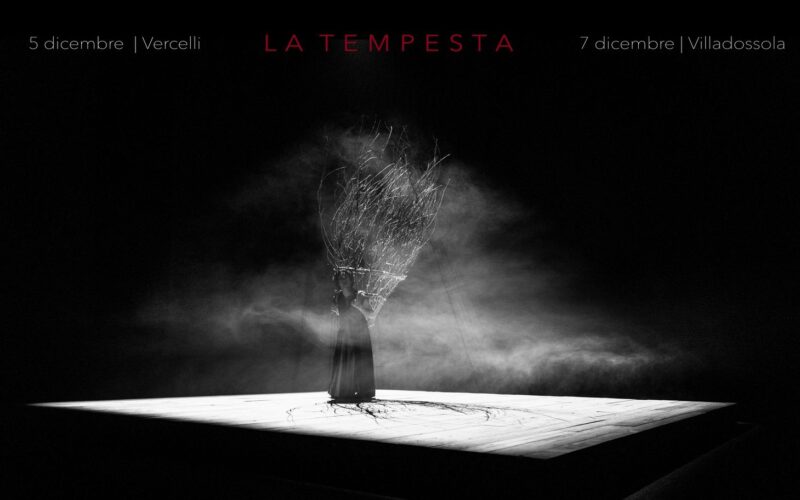The curtain rises on the evening of December 5th at the Civic Theater of Vercelli, and the audience is immediately transported into a universe where Alessandro Serra’s scenography reigns majestically. Witnessing William Shakespeare’s “The Tempest” was a journey into the depths of theatrical art. Shakespeare’s original play, with its plot weaving magic, power, and redemption, served as the foundation upon which Serra built a breathtaking visual interpretation, overseeing direction, sets, lighting, sound, and costumes.
The light, a vital element of the staging, does more than illuminate; it shapes the scenic space, becoming a silent yet powerful character. Beams of light sketch, outline, and breathe life into the actors, while walls of black drapes absorb and expand the brightness, creating a play of shadows and reliefs that seem to dance with the plot itself.
Each element on stage is a fragment of a larger puzzle, a detail in a picture that unfolds before the audience’s eyes. The costumes, faithful yet innovative, blend with the actors’ movements, reminiscent of director Peter Greenaway’s pictorial scenes, where every gesture is laden with meaning and every pose is a work of art. The play unfolds in a series of living pictures, with the glancing light sculpting faces and figures, enhancing features as in a Caravaggio painting, where light and dark engage in an eternal contrast.
The actors, with a performance that leaves no room for doubt, carry the audience through the spectrum of human emotions. Their performance is a continuous dialogue between Shakespeare’s words and the body that expresses them. The play, infused with bawdy moments as was customary at the time, plays with contrasts, maintaining the lightness that is the hallmark of the English playwright, while touching on deep and universal themes.
The climax of the show is the dance, a moment of pure theatrical ecstasy, with music evoking the dark and evocative “Vampire Masquerade” by Peter Gundry. It’s a nod to masked balls, an invocation of ancient and mysterious times. The scene of the “monster” dancing and performing acrobatics, complete with tuba and tails, unfolds with humor that borders on the grotesque, a clear nod to Mel Brooks’ “Frankenstein Junior”, introducing a divertissement that balances the drama and intensity of the preceding scenes.
Finally, the stage presence of Caliban, Trinculo, and Stefano vividly recalls the essence of Neapolitan commedia dell’arte. With their comical vulgarity and exchanges of absurd banter, these characters seem to embody the archetype of Pulcinella, with its intricate entanglements and borderline surreal situations. The interaction between these three characters, full of misunderstandings and jests, brings a breath of genuine, often improvised comedy that has long been a symbol of the Neapolitan theatrical tradition, adding a unique flavor to the show that perfectly blends with the magical and surreal atmosphere of Shakespeare’s narrative.
Thus reinterpreted, “The Tempest” is more than a performance: it is a celebration of theater as a visual and narrative art, where every minute detail contributes to a total experience. It is a work that captures the essence of human tragedy and comedy, leaving the audience with a sense of wonder and contemplation that lingers well beyond the final applause.












